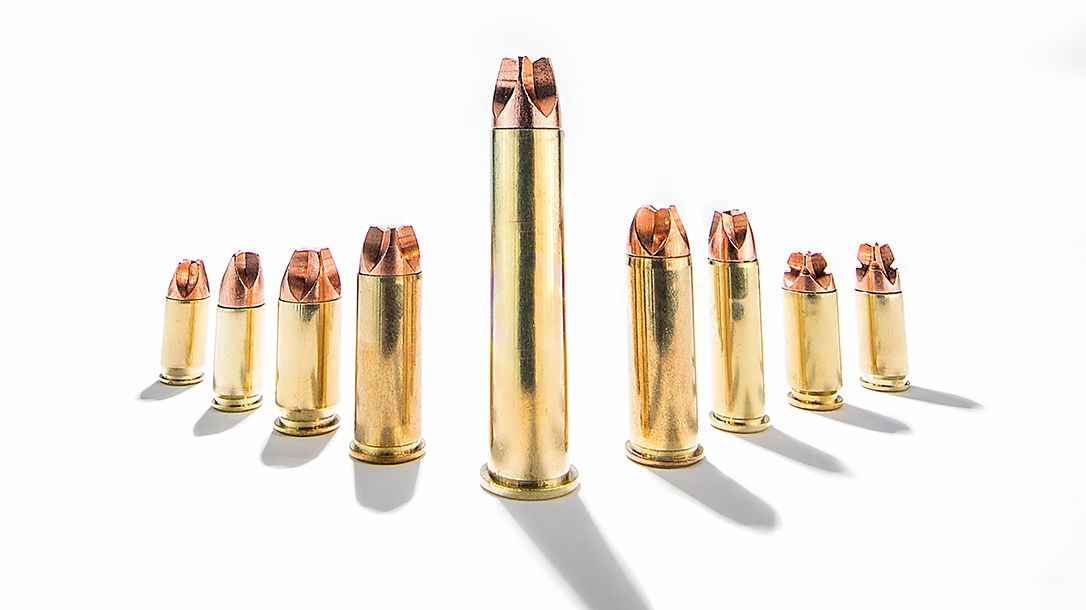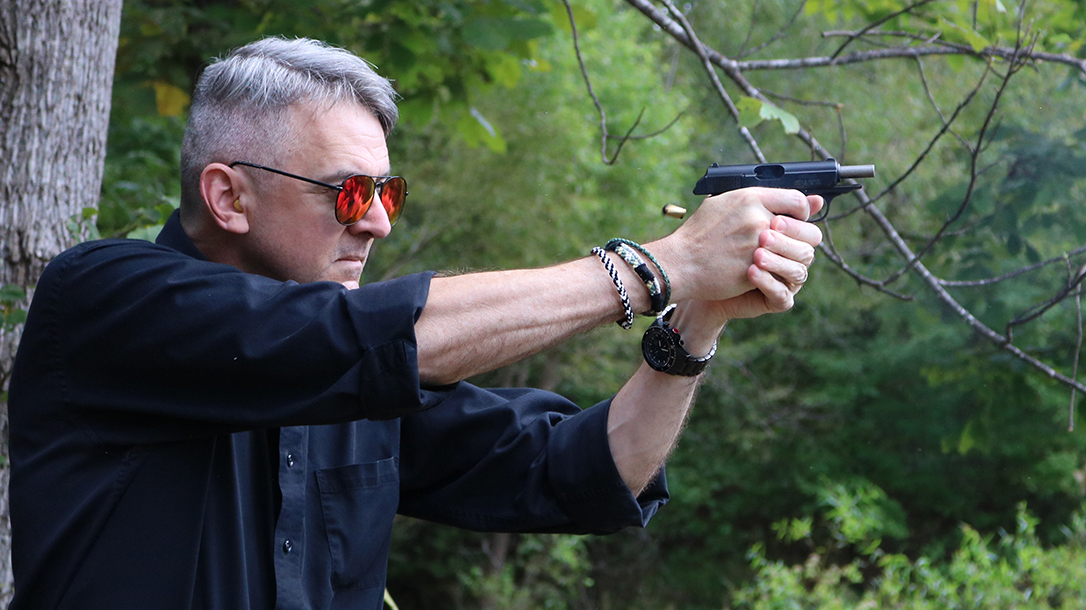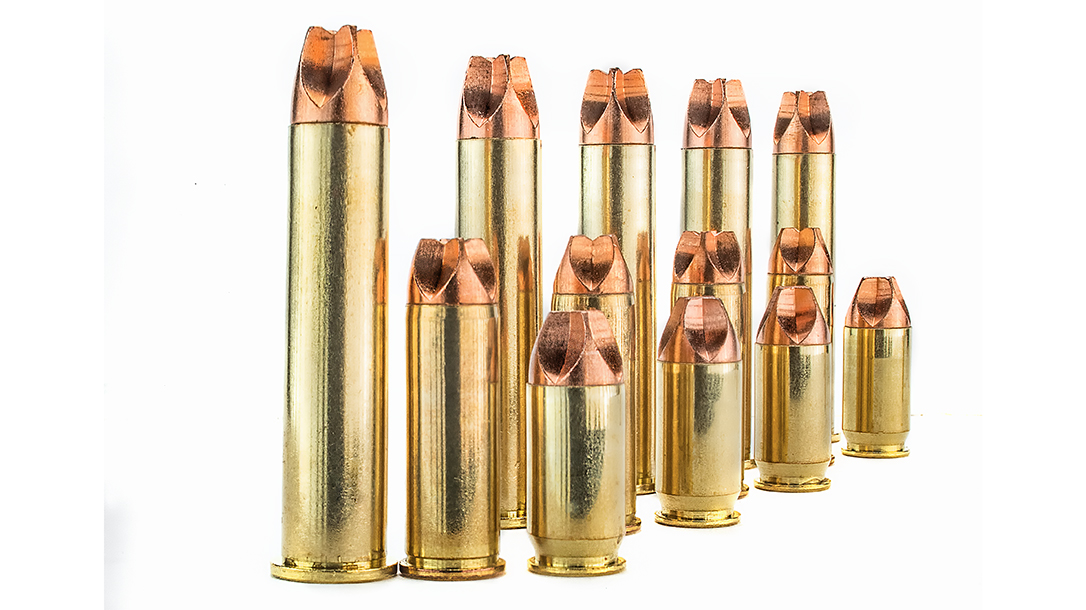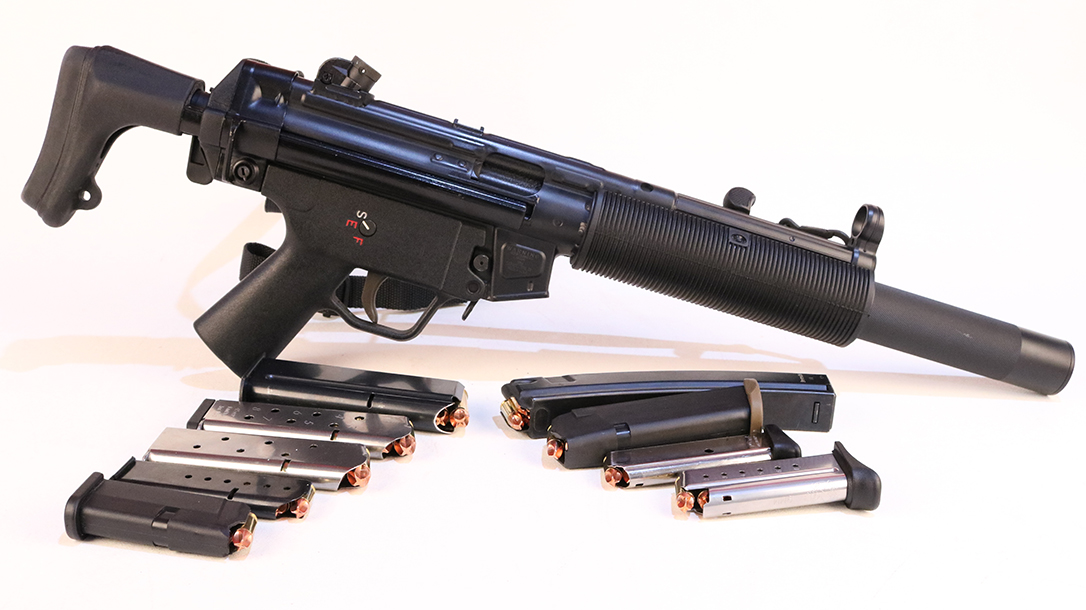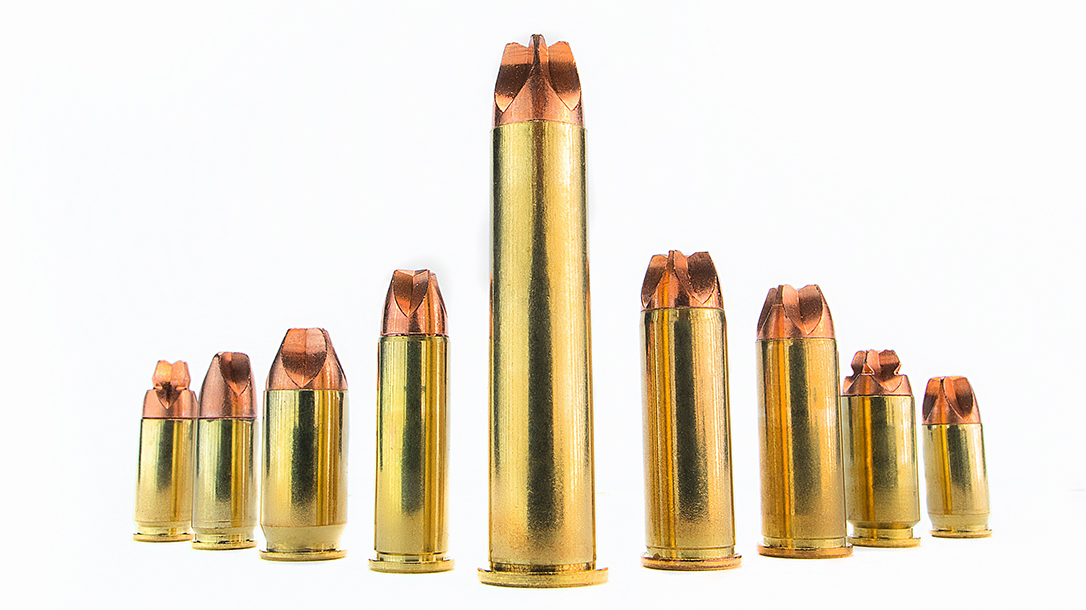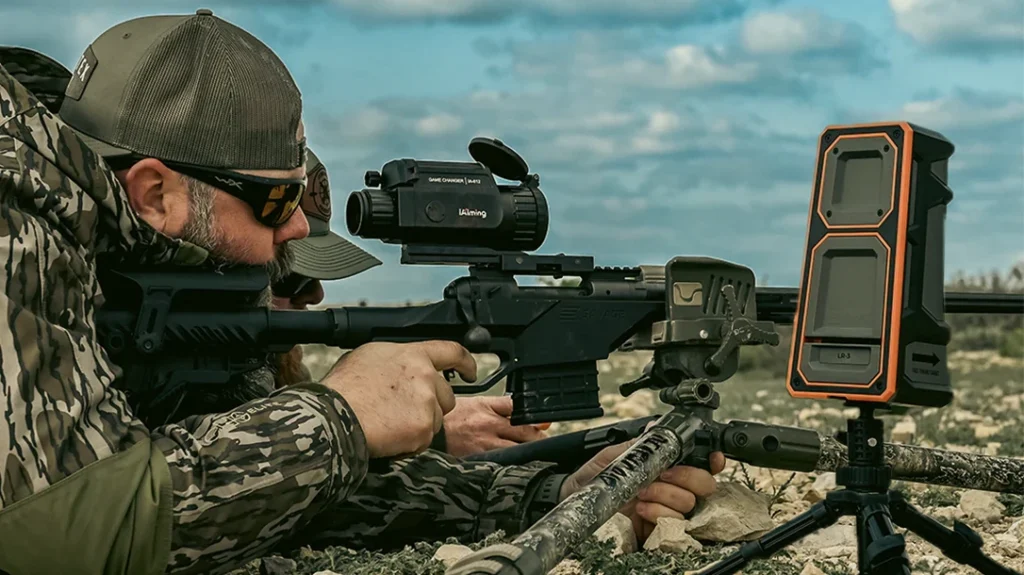When Jeff Hoffman of Black Hills Ammunition joined forces with Dave Fricke of Lehigh Defense to produce a radical new line of defensive ammunition, they threw away the textbook and started from scratch. Their mission was to create a truly barrier-blind bullet that would achieve breathtaking penetration and terminal performance independent of intervening stuff like glass, clothing, wallboard or automotive body panels. To get there, they rethought what it meant to build bullets.
Black Hills Honey Badger
This patented Black Hills ammo pushes Fluid Transfer Monolithic (FTM) projectiles. Each CNC-machined, solid-copper bullet is custom-designed for the particular weight and velocity unique to the caliber. These premium defensive rounds are offered in eight different calibers and nine different loadings. They call these nasty little monsters Honey Badger rounds.
Advertisement — Continue Reading Below
The Namesake
The 2002 Guinness Book of World Records lists the honey badger as the world’s most fearless animal. This remarkable creature isn’t particularly imposing—a big male specimen might weigh 30 pounds—but this compact member of the weasel family just drips attitude. The honey badger isn’t afraid of anything.
God gave the honey badger a few natural advantages. Its skin is preternaturally thick and loose, so it can maneuver violently in close combat. It has vise-like jaws and overbuilt claws that allow it to both fight and dig with alacrity. However, what really makes the honey badger so formidable is its utter fearlessness.
Honey badgers will fight lions, leopards, porcupines and Cape buffaloes. They feed on cobras. An animal cannot get hungry enough to successfully eat a honey badger. It has no natural predators.
Advertisement — Continue Reading Below
A hilarious YouTube video entitled “The Crazy Nastyass Honey Badger” has logged 92.3 million views. If you are one of the unenlightened, then put down the magazine and go check it out. Take your time. I’ll still be here when you get back. There’s just no better name for the world’s nastiest defensive ammunition.
The Physics
Bullets are like little chaos batteries. Your firearm takes chemical energy bound up in gunpowder, temporarily imparts it into that little bit of metal and then transfers the resulting kinetic energy into your intended target, maximizing its destructive effects. How well it performs is a function of the bullet’s energy, and how effectively it translates that energy into a target.
In the past, that energy dump was a function of how much you could expand the bullet within a target medium. A soft lead core nestled within a copper jacket—typically sporting a hollow point—would expand outward and let hydrostatic braking dump kinetic energy. Molecularly bonding the jacket to the core minimized the risk of fragmentation and provided a quantum advance in effectiveness. The sundry details of bullet geometry, cavity design and controlled expansion embodied a simply breathtaking amount of science. Then we started shooting these things through stuff, and everything got exponentially more complicated.
Advertisement — Continue Reading Below
A bullet that performed explosively in bare flesh might clog up with intervening thick cloth and behave no better than a pedestrian FMJ round. The bullet that shredded its way through cloth and kapok might totally choke when encountering windshield glass. The variables became labyrinthine, and the results at times inscrutable. In many cases, the best we might have hoped for was a decent compromise. Jeff Hoffman and Dave Fricke just weren’t satisfied with that.
The Solution
The most critical aspect of bullet performance is penetration. A bullet that fails to punch deep runs the risk of not reaching the good stuff. As a result, each HoneyBadger load is custom-designed to attain optimal penetration standards.
These bullets are cut from solid copper, so they don’t expand at all. That’s where they so fundamentally depart from conventional dogma. The effectiveness of the HoneyBadger comes from two critical aspects of the bullet’s geometry.
Advertisement — Continue Reading Below
Each HoneyBadger bullet sports either three or four flutes cut longitudinally into its body. These flutes begin at the nose as a series of flat blades with stark edges. This design creates a cutting tool not philosophically unlike the spade bit you might use in an electric drill. These sharp-edged blades cut through intervening materials just like a drill bit.
The trailing flutes form spirals that tend to force material down and out in the manner of a gas turbine. This translates into violent jets of incompressible organic stuff pushed radially outward as the bullet transits flesh. These flutes actually accelerate the fluid outward to a speed substantially higher than the forward velocity of the bullet. Trust me, it’s physics.
Proven by Performance
As Jeff explained the science to me, he had this to say: “The market is used to seeing crazy claims and loud advertising. That’s not us. This is real, and we can demonstrate it.”
Advertisement — Continue Reading Below
I’ve since studied the experimental data myself. It is compelling. The end result is formation of a wound cavity comparable to that produced by more conventional rounds while maintaining reliably deep penetration despite intervening barrier materials.
A typical concealed-carry pistol chambered in 9mm today might sport a barrel with a 1-in-10-inch twist. If the HoneyBadger bullet is moving at 1,300 feet per second (fps), that gives the projectile a rotational velocity of 93,600 revolutions per minute. While all that rotational inertia keeps any bullet flying reliably straight, the HoneyBadger design translates that rotational energy into destructive force much more efficiently than might be the case with a more conventional projectile.
The Spectrum
A .380 ACP projects a fraction of the muzzle energy of a .44 Magnum. As a result, each CNC-machined HoneyBadger bullet is designed to perform optimally within the constraints of its particular caliber. That makes each projectile just a wee bit different.
Advertisement — Continue Reading Below
All of these bullets have either one or two cannelures milled circumferentially to provide a nice gripping spot for the case mouth. This keeps the bullets from setting back when they strike the feed ramp and ensures consistent, reliable performance. Each bullet sports a cross-sectional architecture that geometrically mimics that of a conventional hollow-point round for reliable feeding. Most of these projectiles also feature a void in the base to facilitate a tight gas seal, in the manner of the old Civil-War-era Minié ball.
The .380 ACP HoneyBadger bullet weighs a mere 60 grains yet travels at legit velocities of around 1,100 fps out of typical short-barreled defensive handguns. The .380 ACP is at the bottom end of the acceptable power spectrum, but this load is optimized to punch as deeply as possible while still taking advantage of the hydraulic shock effect intrinsic to the design.
By contrast, the .44 Magnum HoneyBadger load pushes its 160-grain solid-copper bullet to around 1,800 fps. In this case, the bullet geometry is designed to spill more energy radially and brake the projectile more aggressively to prevent overpenetration. Each load is optimized for its own performance envelope between these two extremes.
Advertisement — Continue Reading Below
Suppressor Ready
Lots of folks run sound suppressors these days, and the 9mm is the most popular handgun chambering on the planet. As a result, the 9mm HoneyBadger comes in two broad flavors. The standard-velocity variant pushes a 100-grain copper slug to around 1,300 fps. The subsonic version launches a 125-grain bullet a bit north of 1,000 fps. Each projectile is designed specifically for its performance window.
The 115-grain .40 S&W and 100-grain 9mm HoneyBadger loads deserve special mention, based solely upon their sinister appearance. The .40 S&W lost a bit of its luster after the FBI went back to the 9mm, but I have seen it do some amazing things in an urban emergency room. These two bullets are notched around their circumference to best extract maximum performance. That also makes them look absolutely terrifying.
The HoneyBadger also comes in .38 Special +P and .44 Special loadings. As these are rimmed wheelgun rounds, the bullets are left a little bit wider at the nose than is the case with the cartridges intended for use in autoloading weapons. The two loads offer spirited performance for these proven combat revolvers.
Advertisement — Continue Reading Below
Finally, Black Hills offers one rifle load in the HoneyBadger line. This .45-70 is a monster that pushes a 325-grain solid-copper bullet to more than 1,700 fps, producing in excess of 2,200 foot-pounds of muzzle energy. Wow.
The Testing
I ran these rounds through a representative sampling of tactical firearms, both common and not so much. The .380 ACP rounds ran like a scalded ape through my Glock 42, Walther PPK/S and Rock Island Armory Baby Rock. The .44 Magnum rounds bellowed out of my Smith & Wesson Model 29, and even cycled my Desert Eagle reliably. The .45 ACP rounds ran just as well in my home-built Stealth Arms 1911 Commander as it did through my high-end, suppressed Kimber Warrior SOC. The 9mm loads chugged along through a suppressed Glock 17, a Polymer80 PFS9, a Springfield Armory XD-S and an HK MP5SD submachine gun just for flavor. Nothing is more reliable. That’s why Black Hills sells 5.56mm match ammo to all branches of the U.S. armed forces.
If you ever have to use your defensive handgun for real, that thing will suddenly be worth more to you than your house. When life goes truly sideways, that uncomfortable, inconvenient little contrivance will be the only barrier standing between you and your family and something truly horrible. Under those circumstances, you want the best defensive ammunition money can buy. The solid-copper Black Hills HoneyBadger is as mean as it gets.
For more information, visit black-hills.com.
This article is from the December 2019 issue of Tactical Life magazine. Grab your copy at OutdoorGroupStore.com. For digital editions, visit Amazon.
